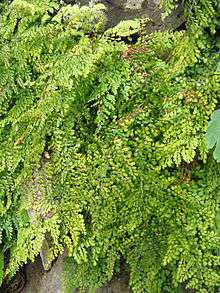Adiantum venustum
| Himalayan maidenhair | |
|---|---|
 | |
| Fronds of Adiantum venustum | |
| Scientific classification | |
| Kingdom: | Plantae |
| Division: | Pteridophyta |
| Class: | Polypodiopsida/Pteridopsida (disputed) |
| Order: | Polypodiales |
| Family: | Pteridaceae |
| Genus: | Adiantum |
| Species: | A. venustum |
| Binomial name | |
| Adiantum venustum | |
Adiantum venustum, the evergreen maidenhair or Himalayan maidenhair, is a species of fern in the genus Adiantum of the family Pteridaceae, native to China and the Himalayas. It is a slow to establish plant that usually grows on moist rocks and soil with a good amount of humus and dead leaves.[1] It is very hardy, largely evergreen to -10 °C, when it becomes deciduous. It is also known as black Hansraj in India for its black stalks at the fronds.[2]
The soft green fronds are triangular, with numerous fan-shaped segments on each frond, with black stems. The roots are rhizomatous. The whole plant forms a slowly spreading mat.[3]
This plant has gained the Royal Horticultural Society's Award of Garden Merit.[4]
Uses
The fern is used for the treatment in cold, headache, hydrophobia, inflammatory of the chest. It is also use as an antiviral or antibacterial drug.[5] The extract from the rhizome can be used to treat diabetes, liver problems and diuretic.[6] It is also suggested that researchers had found ethanolic extract of the leaves and stems of the plant, which is composed of terpenoid, phytosterols, flavonoid, and saponin, are things that control cancer activities. The extract was injected into mice. However, the fern's extract can cause sedation, muscle relaxation and hypnosis in mice.[7]
References
- ↑ Burrel, C. Colsten (May–June 2002). "What to Plant Himalayan Maidenhair, Adiantum venustum". Horticulture: 104.
- ↑ Puri, H. S. (1970). "Indian Pteridophytes Used in Folk Remedies". American Fern Journal. 60 (4): 137–143. doi:10.2307/1546353. JSTOR 1546353.
- ↑ RHS A-Z encyclopedia of garden plants. United Kingdom: Dorling Kindersley. 2008. p. 1136. ISBN 1-4053-3296-4.
- ↑ "RHS Plant Selector – Adiantum venustum". Retrieved 11 June 2013.
- ↑ Alam, M. Sarwar; Chopra, Neeraj; Ali, Mohammad; Niwa, Masatake (1 May 2000). "Normethyl pentacyclic and lanostane-type triterpenes from Adiantum venustum". Phytochemistry. 54 (2): 215–220. doi:10.1016/S0031-9422(00)00063-7.
- ↑ Nwosu, Maria O. (1 January 2002). "Ethnobotanical Studies on Some Pteridophytes of Southern Nigeria". Economic Botany. 56 (3): 255–259. doi:10.1663/0013-0001(2002)056[0255:esospo]2.0.co;2. JSTOR 4256579.
- ↑ Viral, D; Shivanand, P; Jivani, N (2011). "Anticancer Evaluation of Adiantum venustum Don". Journal of Young Pharmacists. 3 (1): 48–54. doi:10.4103/0975-1483.76419. PMC 3094560. PMID 21607054.
| Wikimedia Commons has media related to Adiantum venustum. |